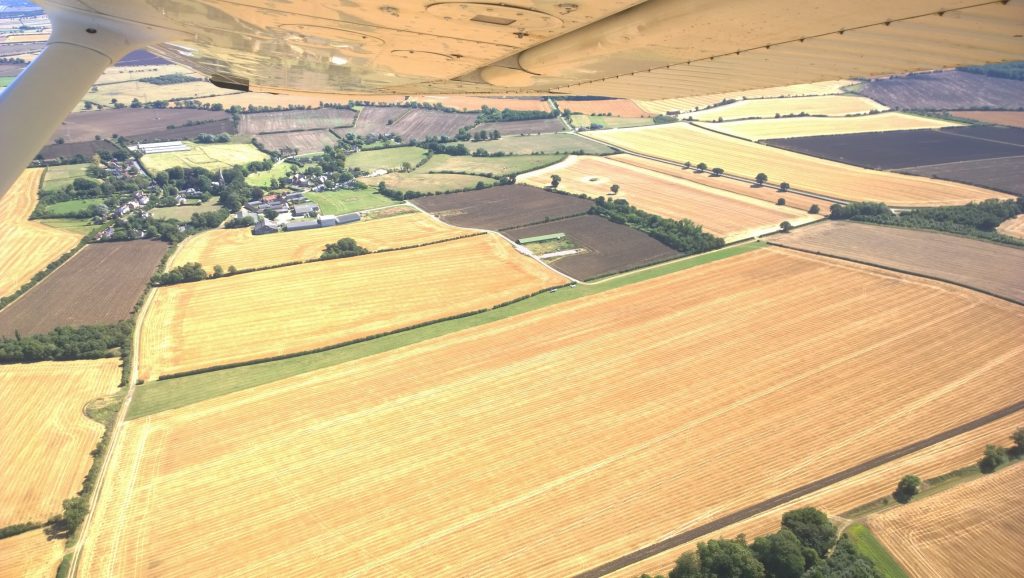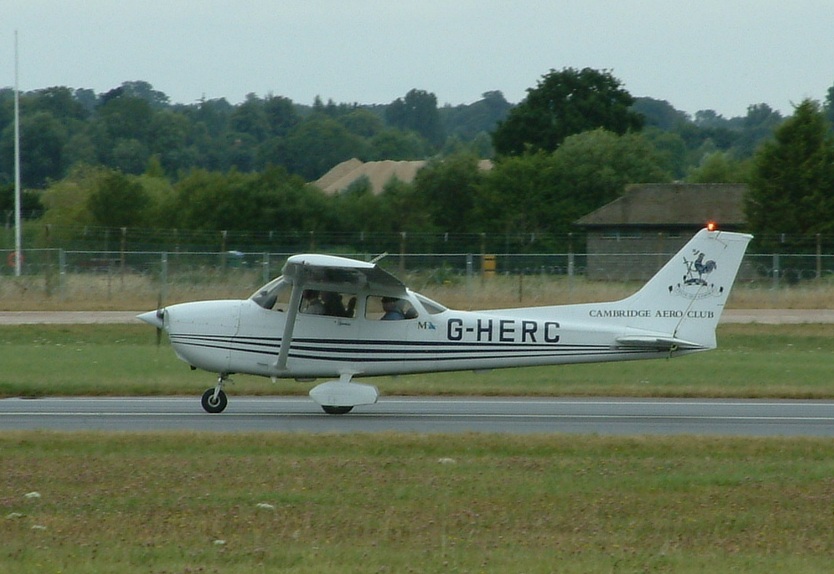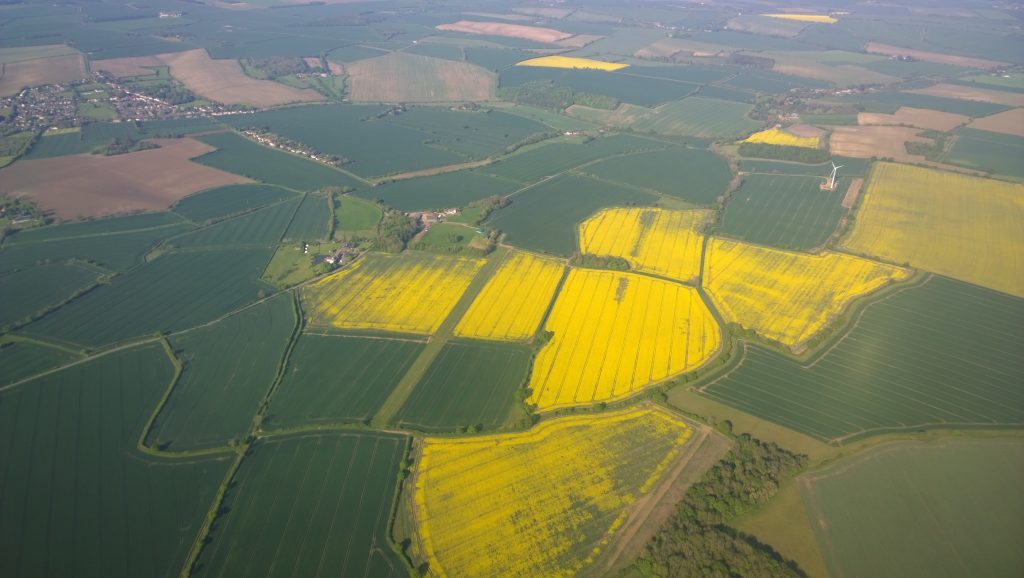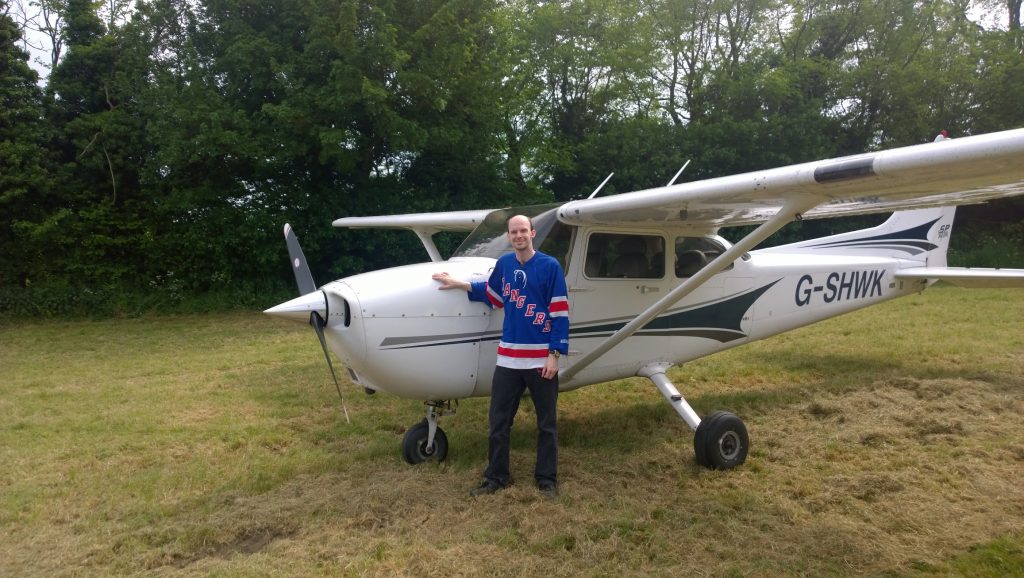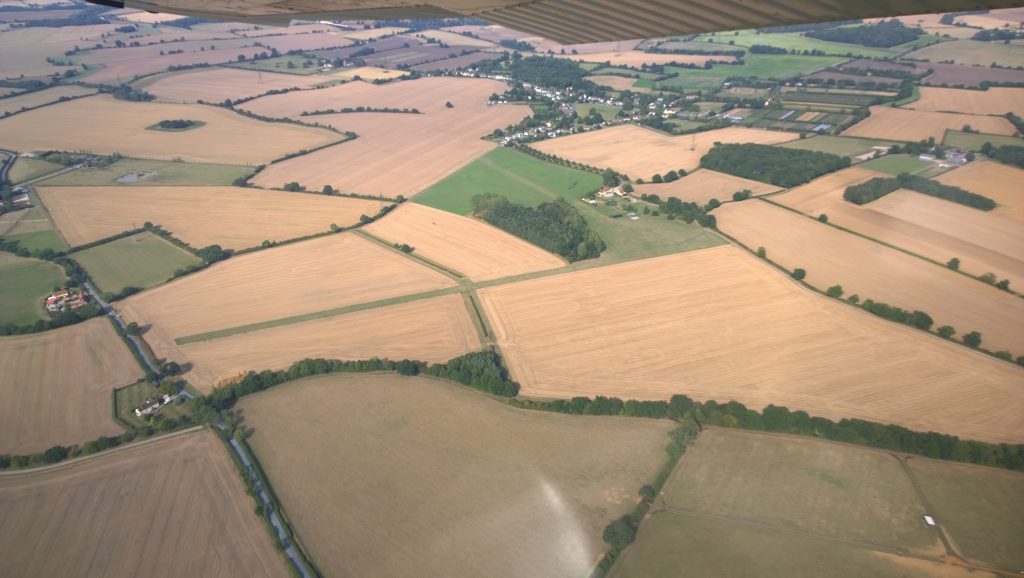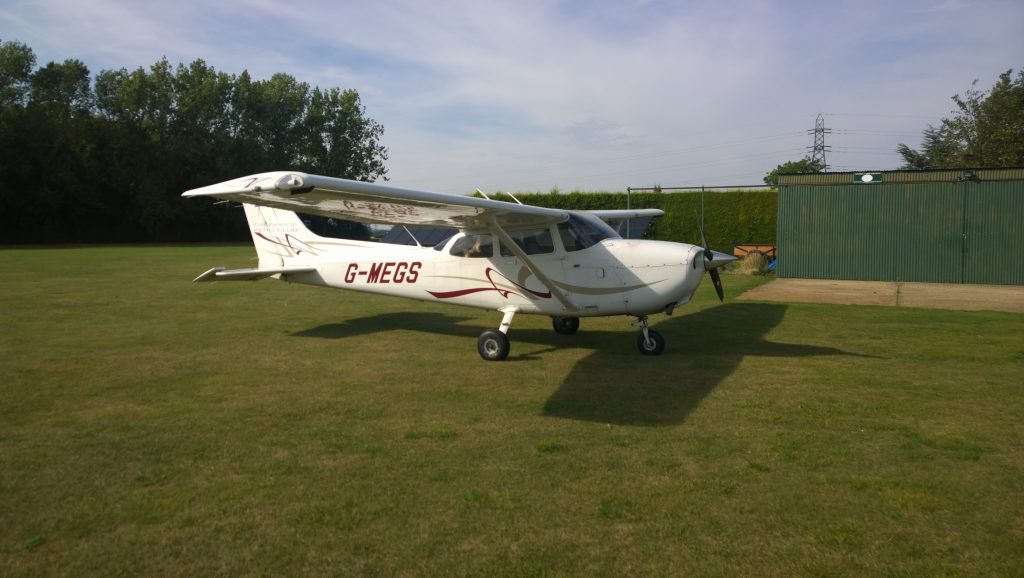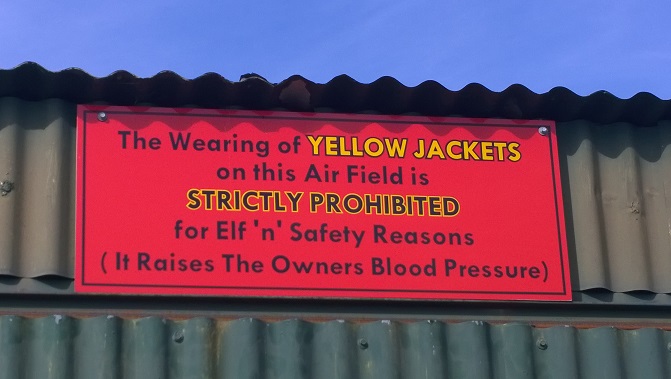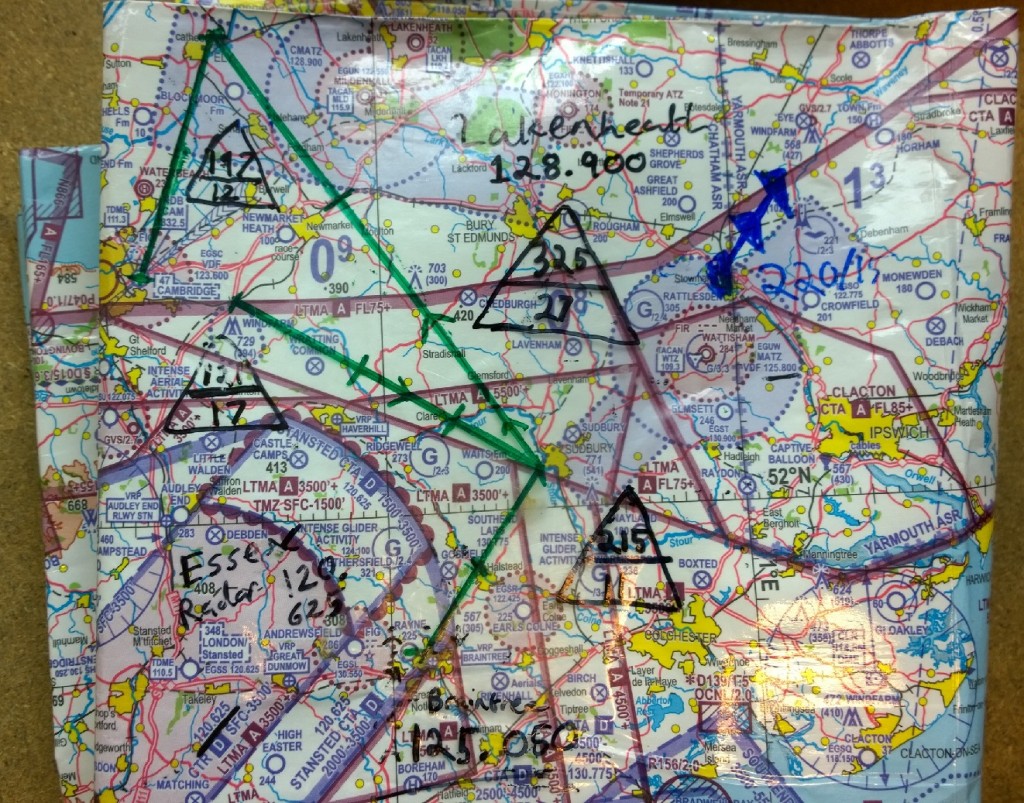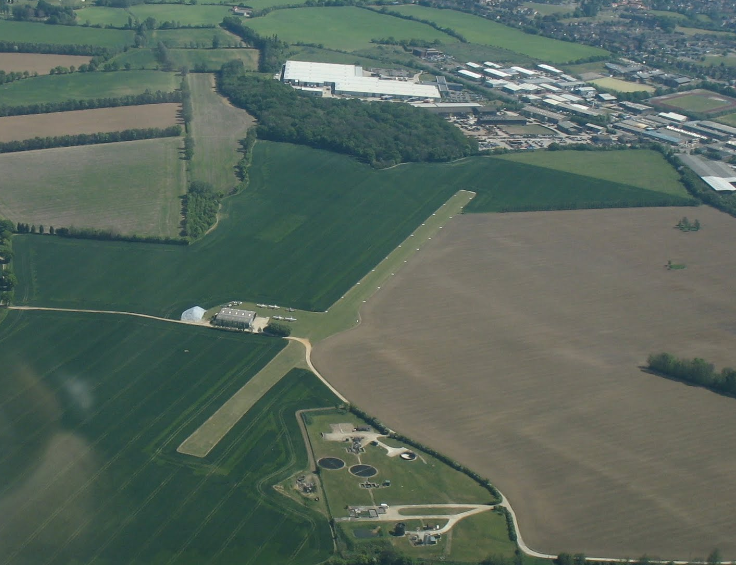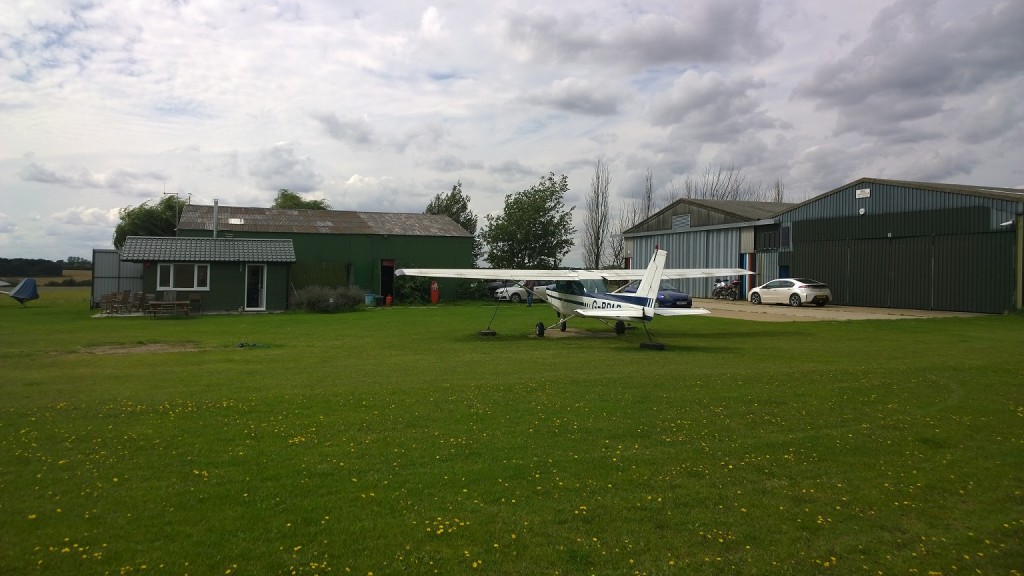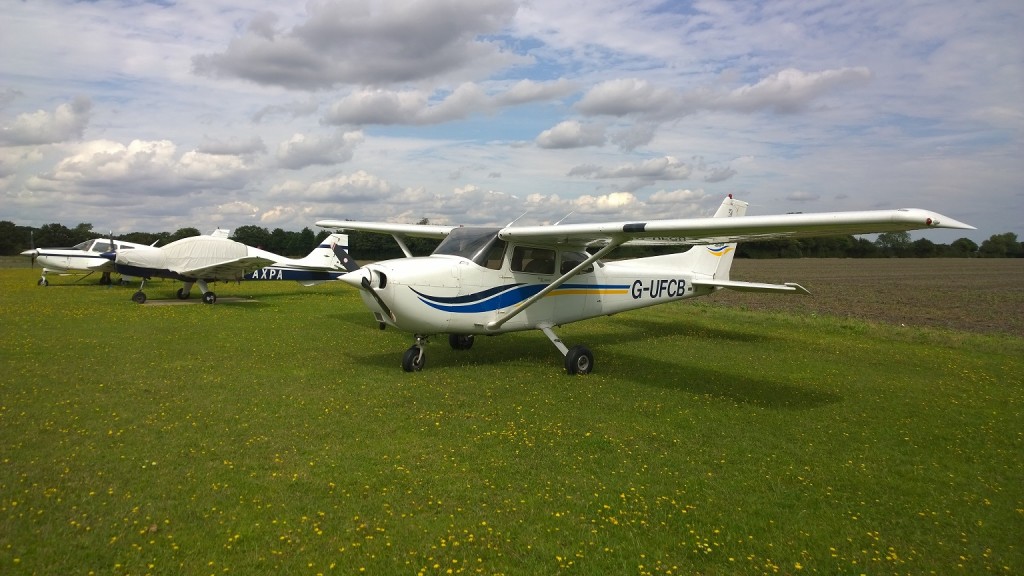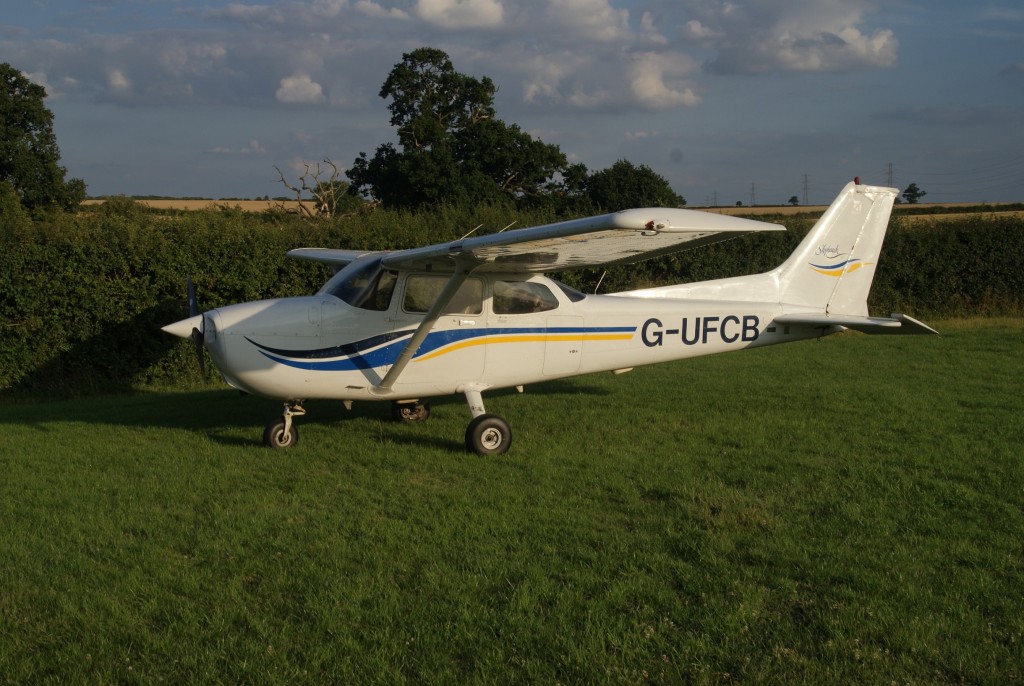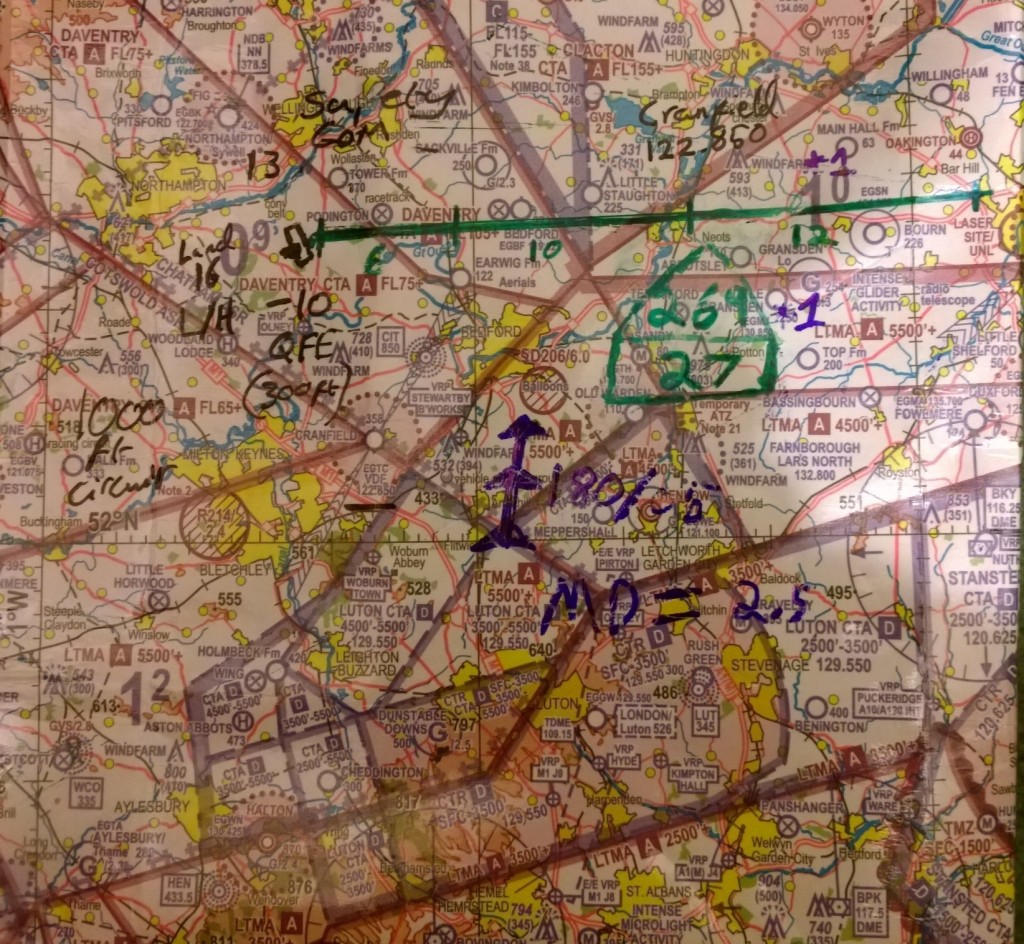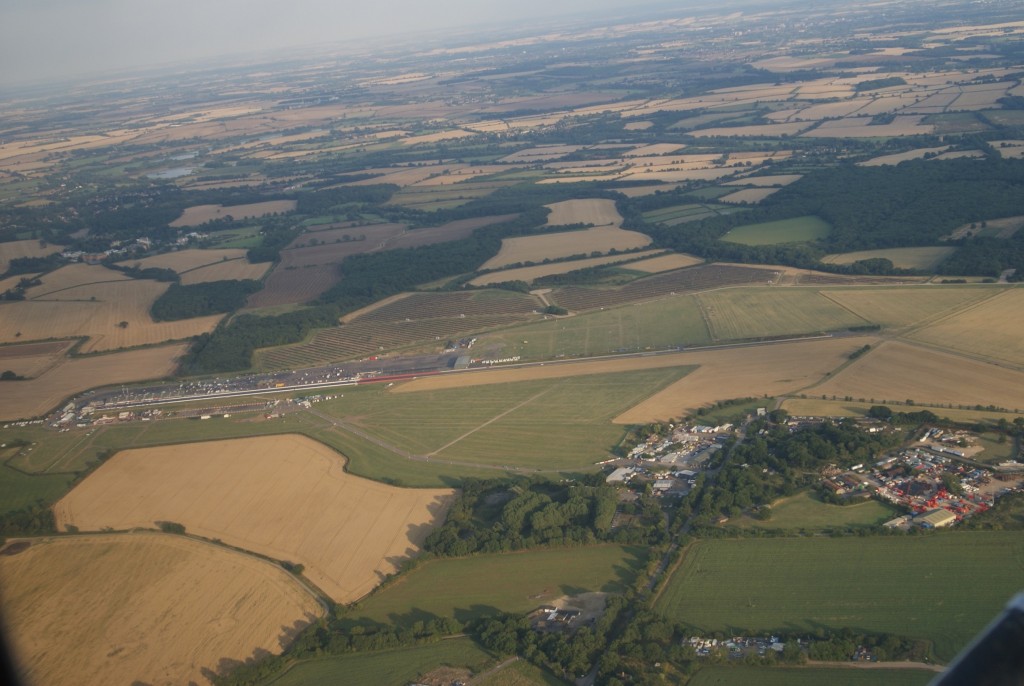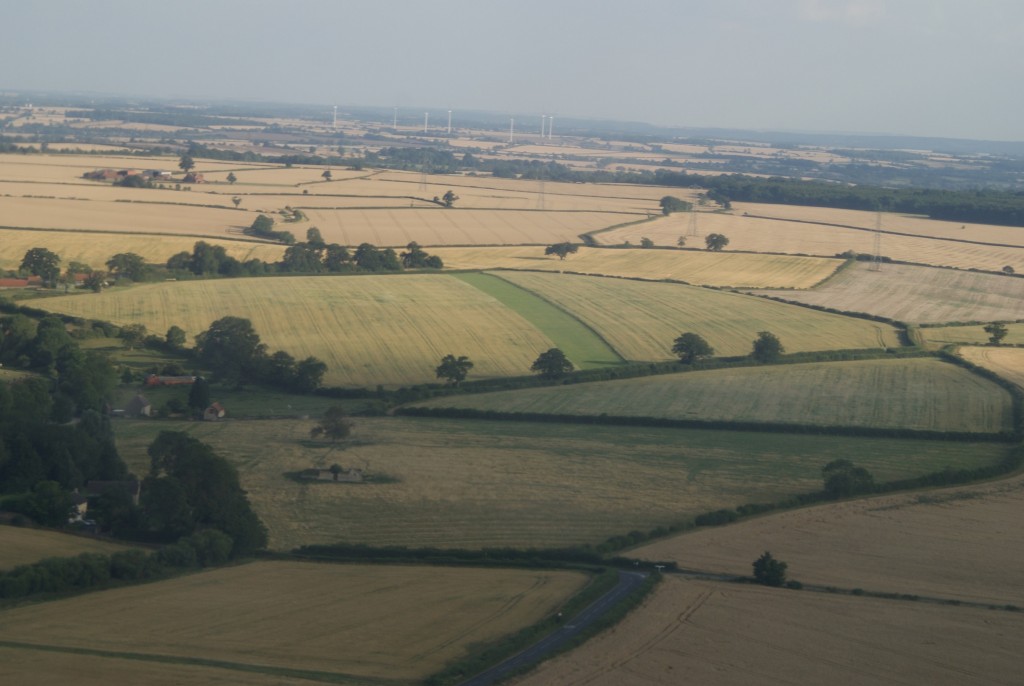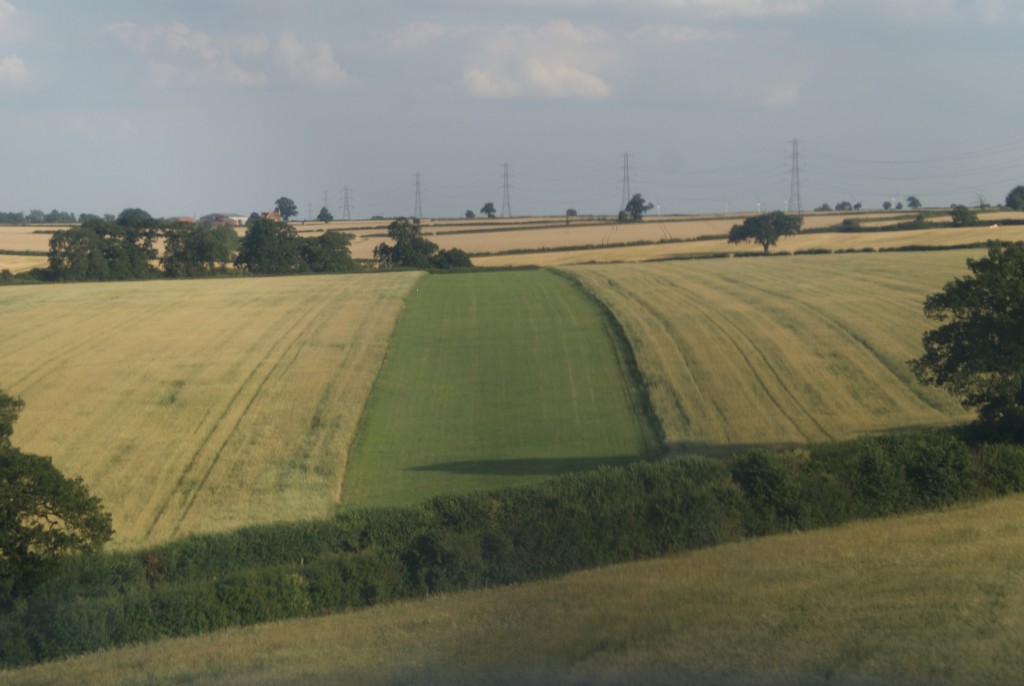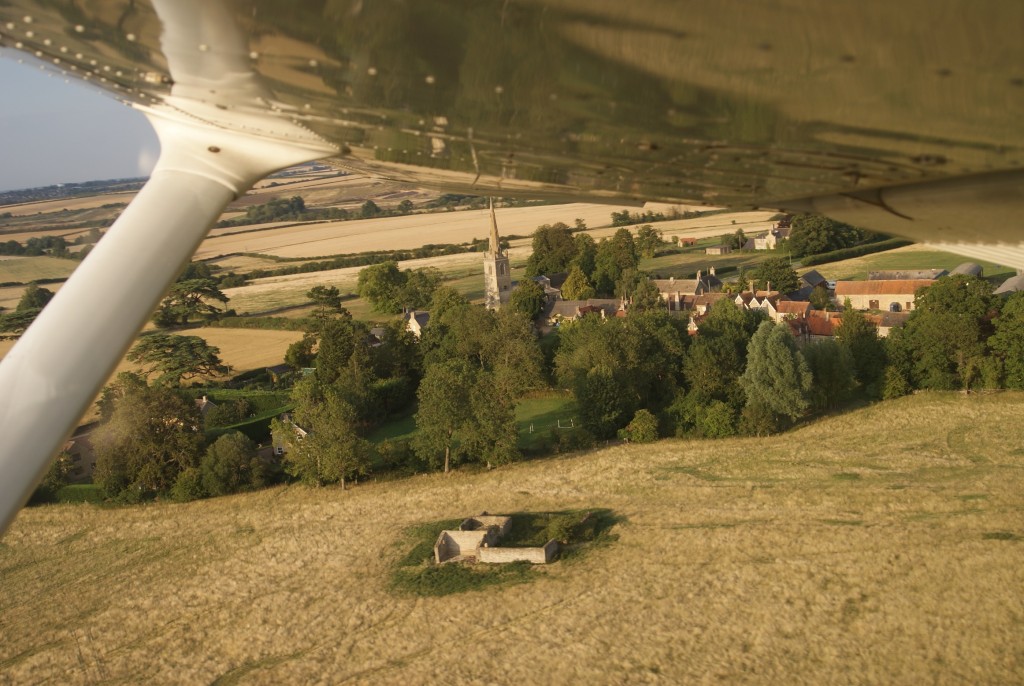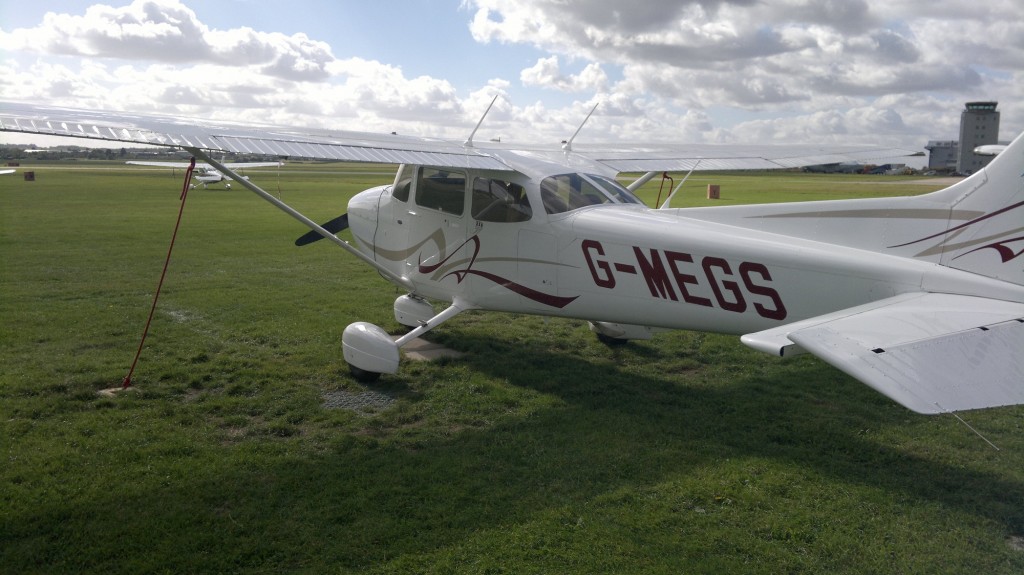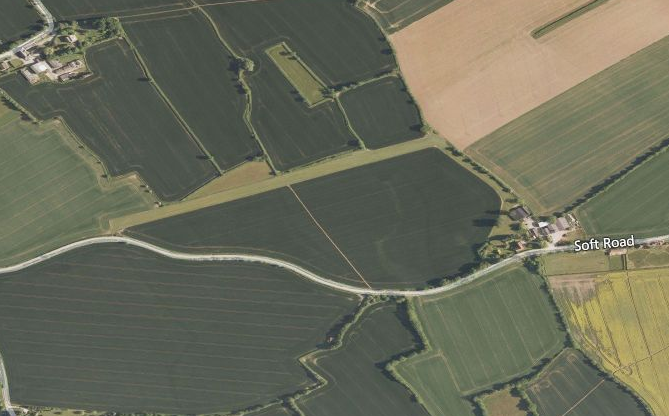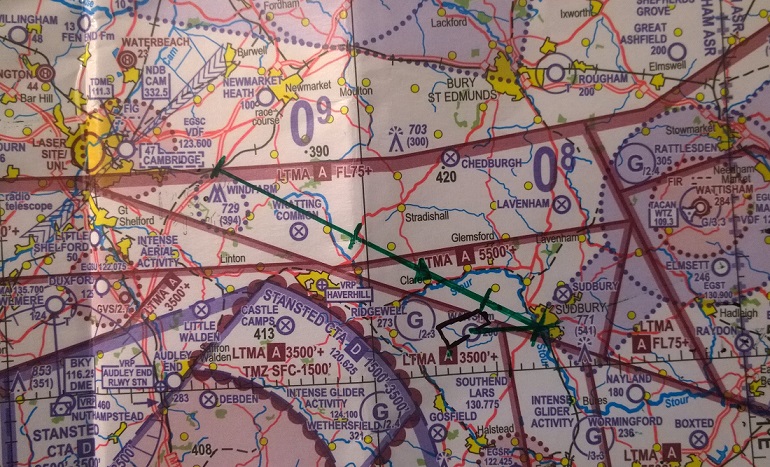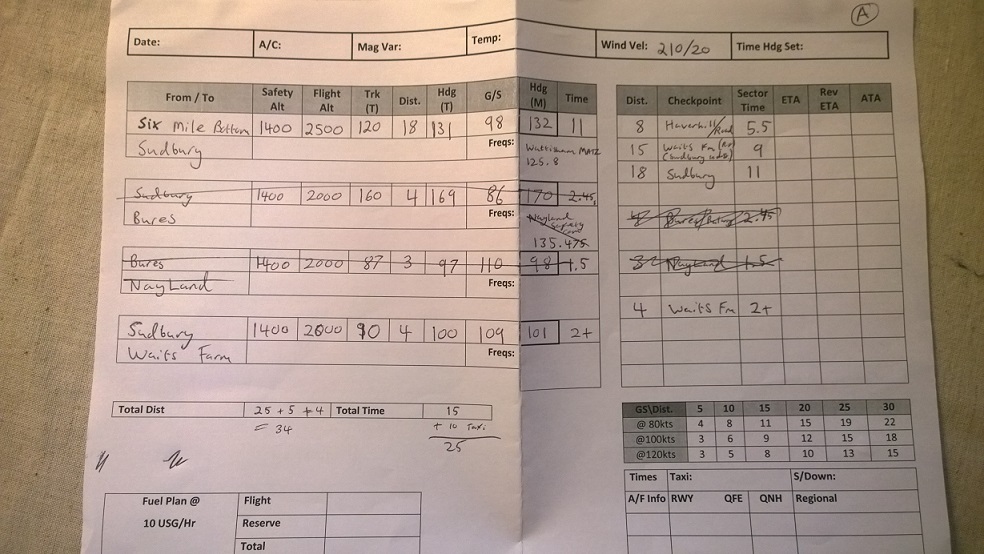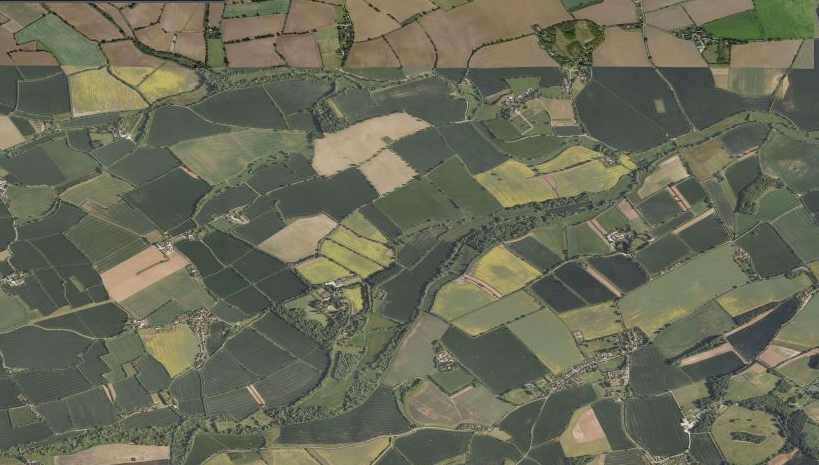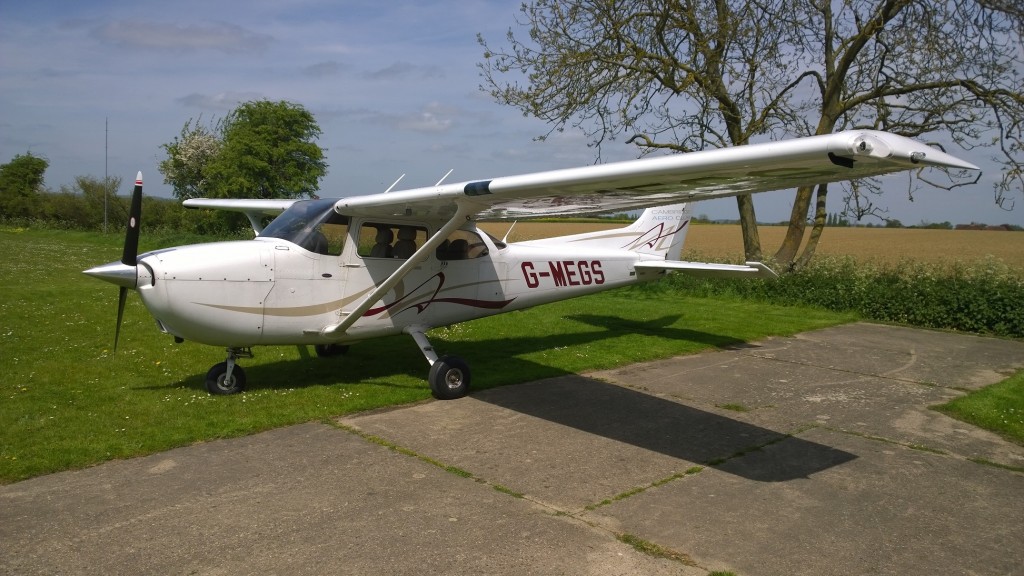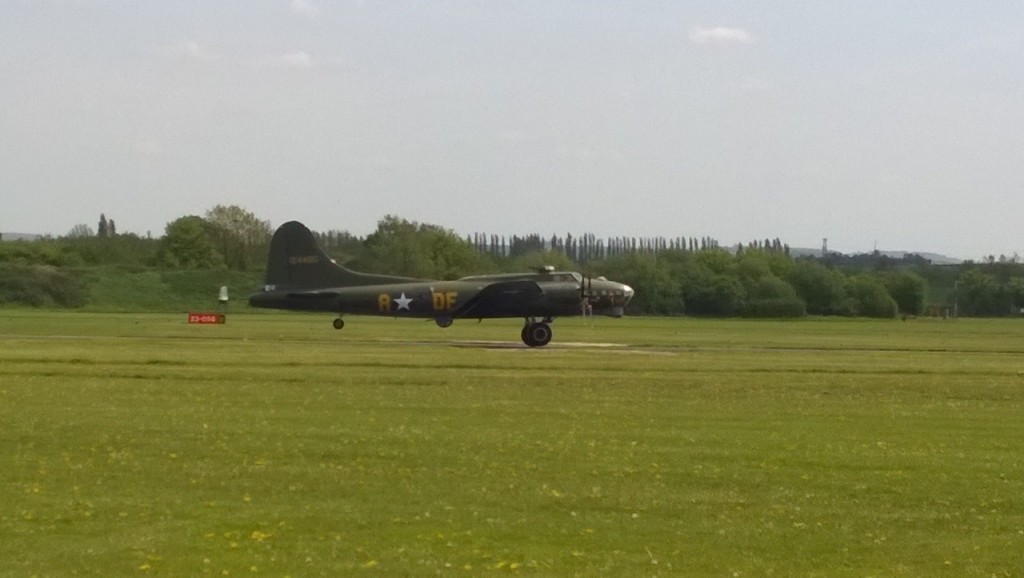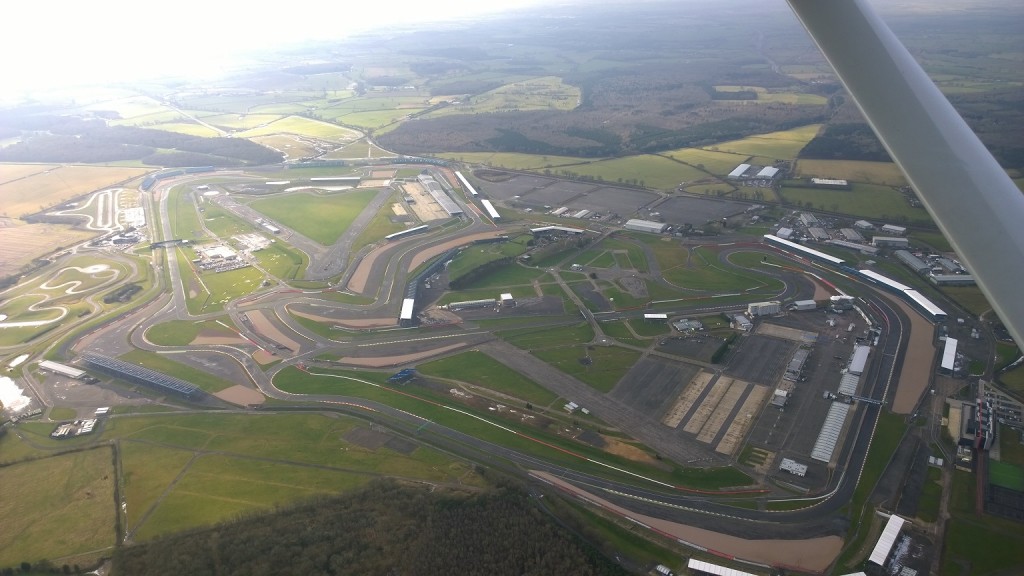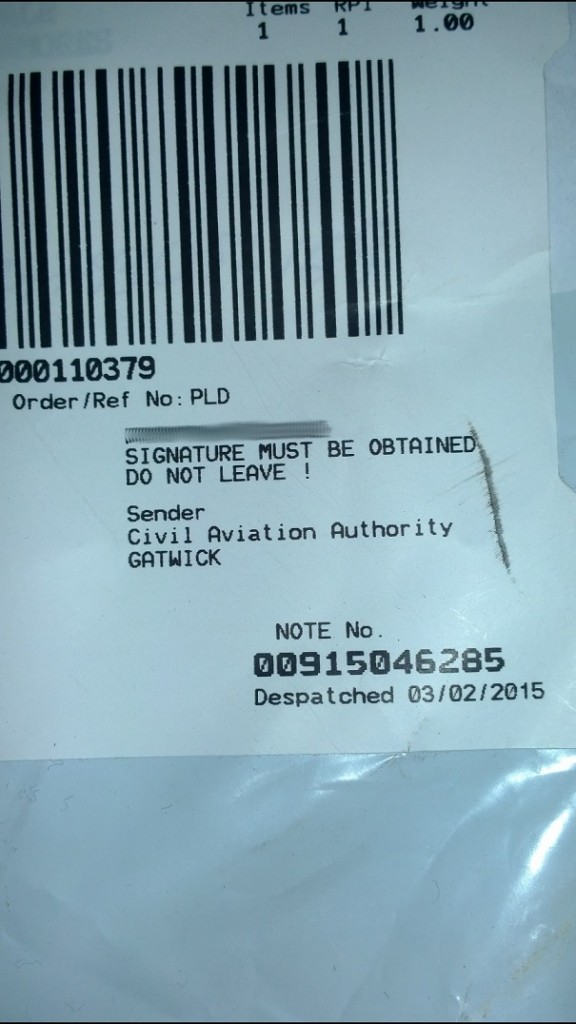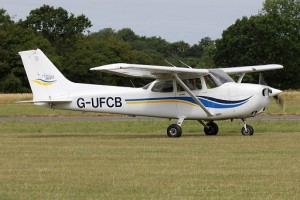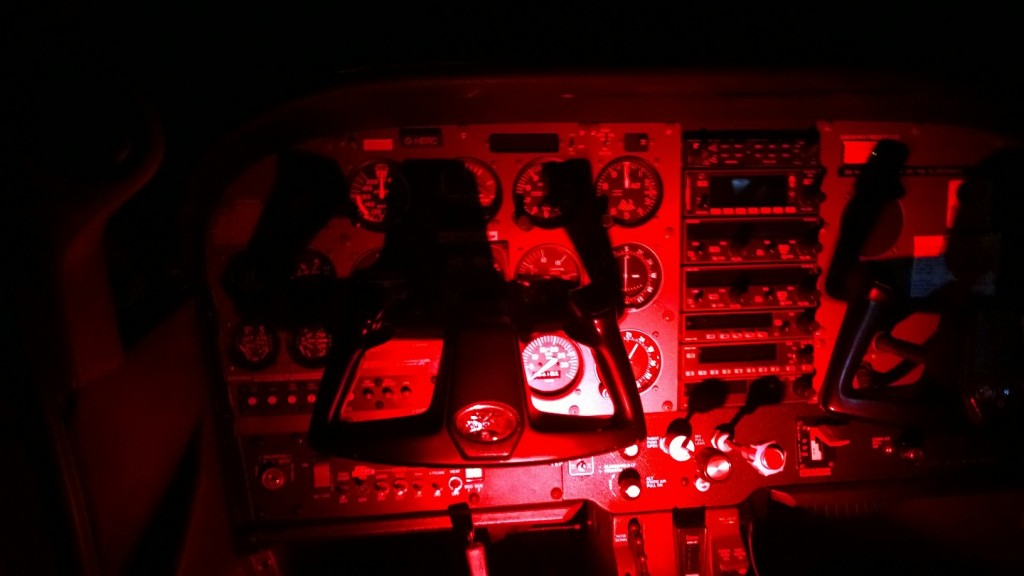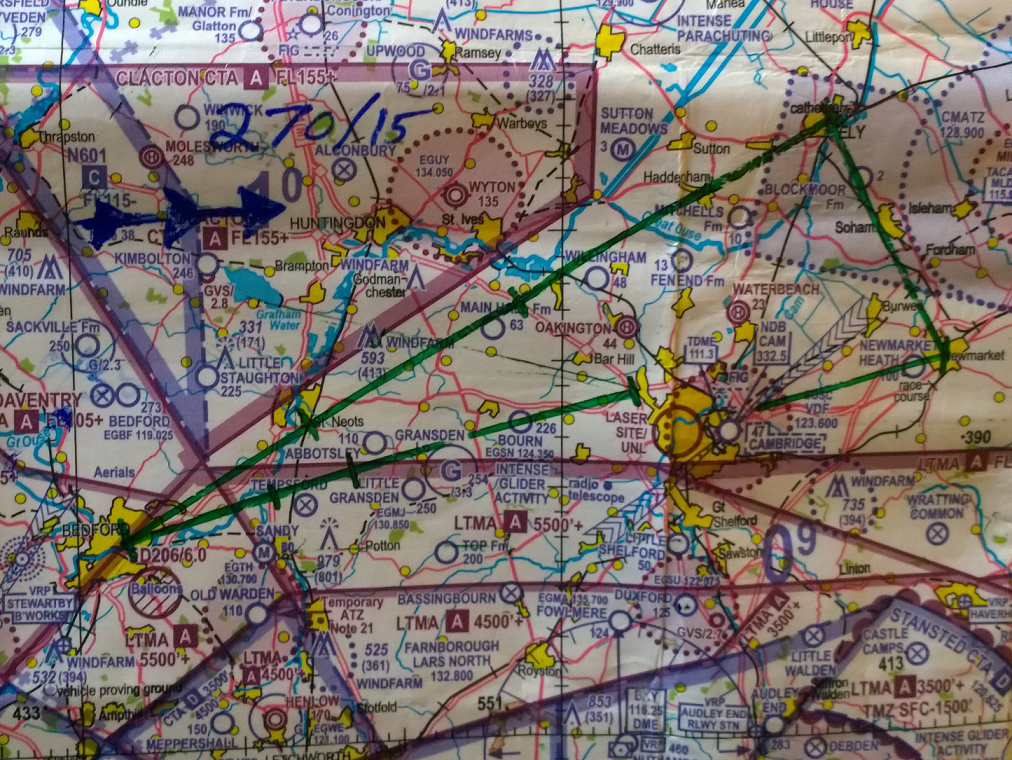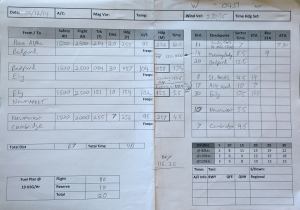A club fly out, the plan as usual was to take the four Cessna 172 SP’s but upon arrival everyone came to learn that one plane (G-MEGS) had recently been involved in an incident and therefore couldn’t go, so there’d be a 182 in the group to replace it. Sad news, I love flying G-MEGS, it’s been to loads of farms with me and last year I took it to Calais, France. I was really hoping to be assigned to it again for this flight, but unfortunately nobody was getting to fly her today and it didn’t sound like she was going to be fixed any time soon 🙁
Briefing
Club fly out briefings are like a box of chocolates, you never know what you’re going to get – until they start. The route had been emailed out and talking to some of the other pilots (all qualified etc.) the consensus seemed to be that if we’d decided one morning to fly to the Isle of Wight, the route provided is not the way we’d have gone.
To cut a long story short, those in my plane all elected to change the route a little – basically instead of doing the leg down to Oxford primarily on Radio Aid’s, we changed it to a route more fitting to how you’d fly it if planned for a purely visual navigation (e.g. Nav Aid’s as a backup, not the primary means of following a track).
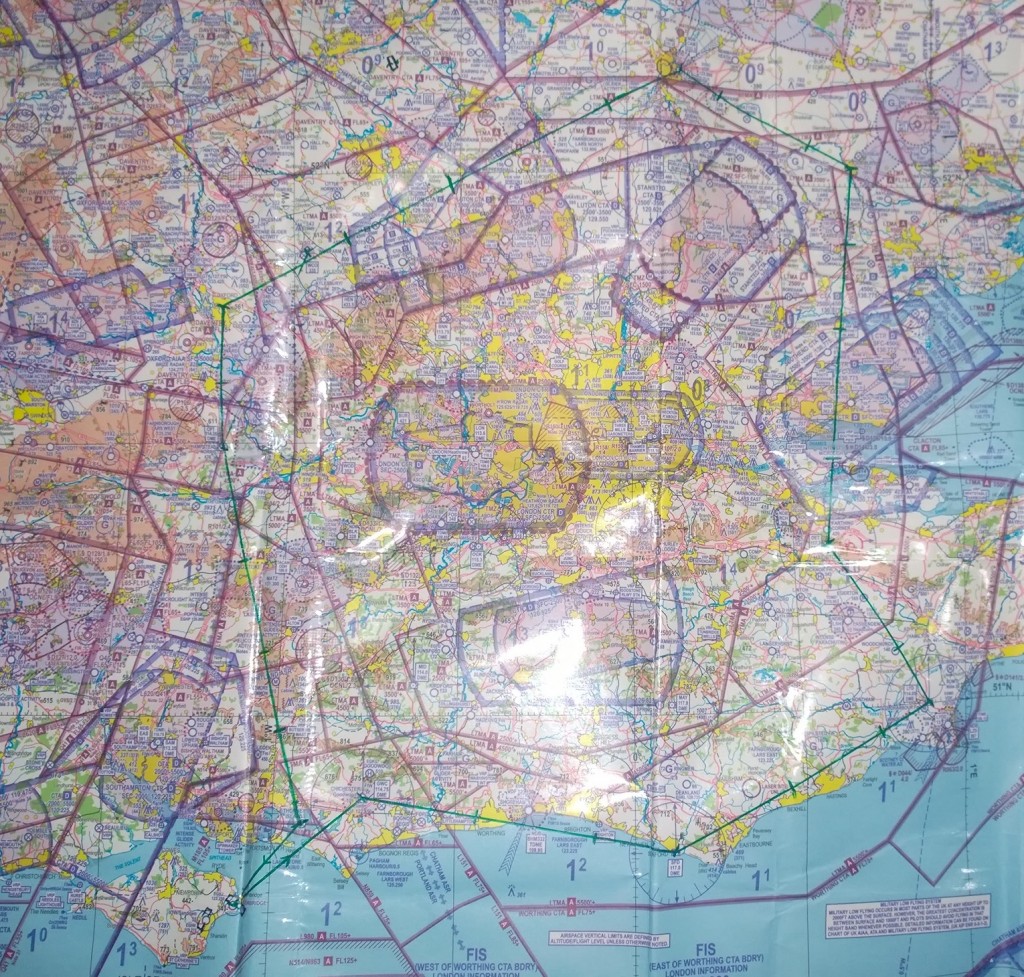
Route: To & From Bembridge Isle of Wight
Any way you cut it, once drawn up on the chart, it still looks like quite an impressive flight! Distance wise it’s pretty immense – like a very scenic route around London 🙂
As normal with these things, one pilot fly’s out there, one does the return leg. Largely because I wanted to get a Bembridge landing in my log book, I pitched to do the first leg of the flight and my fellow pilot had no issues with doing the return route back (a very scenic route), so that was all agreed – he checked out the plane, I put the winds into our new route and we were soon good to go.
Nice to fly with other pilots
I’m still a bit uncertain where I stand on flying with other pilots in the front, but I’m used to having an instructor in the plane from my training and back seat pilots don’t phase me because I’ve done that before. I’m sure eventually I’ll do a flight with another pilot where we just split the thing into two solo halves but I’ve yet to do it – I guess it’s a psychological thing, I have my ways of flying solo, if I flew with someone else they might find them bonkers…….I mean, I fly map and compass and look out of the window, how very old fashioned! 🙂
On club fly outs though with a pilot in the back and instructor ready to man the radio’s etc. it’s really quite a fun experience.
All the planes took off whenever they were ready, so instead of bunching up into a formation there was a good 10 minutes between each plane which I think kept things calm with Air Traffic Control on the departure.
I Spy with my Little Eye : The Airfield Edition
The first leg down to oxford really was like a game of “I spy”, but with airfields, as you can see from the map there’s quite a lot of airfields left/right of the route: Top Farm, Basingbourn, Old Warden, Meppershall, Homebeck Farm….
This made for a great game of ‘name that airfield’, although the danger with this is you can quickly be talked into thinking you’re somewhere you’re not when others are shouting “on the left must be……” a couple of times we were 3-5 miles further south then we actually were, but this is all really good visual navigation practice as you can soon put the pieces together to correct (e.g. Meppershall has one main grass runway, running north/south. Henlow has a triangle configuration of grass runways).
Heading Indicator Precession
Wiskey Kilo’s heading indicator, in my experience, has a tendency to precess – today was no different, it was going a bit mental really. Initially I didn’t spot it, but then the world outside suggested we were flying off course, so I corrected for it and made some tweaks to compensate for wind forecast error. That didn’t really fix it though, then I looked at the Heading Indicator Vs the Compass (FREDA checks are good things), the heading indicator was now coming up to ten degrees off from the compass!
It wasn’t long though before it was doing it again 🙁
Just have to keep a good eye on the heading.
Oxford: Very Excited Air Traffic
Approaching Oxford I was maybe 3 miles north of track, we could see Oxford city so pretty sure of our position and in the distance we could just make out Oxford airport (not brilliantly, but you sort of get used to how airports look from a far after a while) and stuff flying around Weston-on-the-Green. All very under control.
I’d switched from talking to Cranfield, to talking to Oxford and this should have been a simple basic service, but instead the ATC guy at Oxford started to get very excited about where we were flying and the amount of gliders in the area. Fair play gliders are always a threat to light aircraft (and vice versa), but even with the knowledge of what we were doing, I had to maneuver the plane south to keep him calm. There was no need for it really, this wasn’t like I was about to breach an ATZ or fly into a flock of gliders he could see etc. (we’d fly into the glider flock later on!), but ehhh sometimes you just have to work with people, keep them sweet etc.
Turning South: Gliders Everywhere!
Flying over the R101 restricted airspace at around 2,600ft we were approaching RAF Odiham. We were talking to them on the radio and they had plenty to say about their intense gliding activity – they REALLY weren’t joking!
First there was a glider on the left, we were keeping a good eye on him and thinking about trying to go round him on the right (rules of the air), but no sooner had we discussed trying to do this the glider started turning right cutting me off! Watching them turn, we spotted another glider cutting us up from right to left above us – we watched them go by ok, but it was starting to get busy.
Then another one, the instructor decided he’d rather not be there any more and took control for a few minutes to throw the plane around a little – essentially getting us further out to the right and away from Odiham, then returning control.
Worrying Southampton
As I flew over Four Marks, south west of Alton, I spotted a really quite nice looking little grass strip to our right. A quick look at the map indicated it must be Colemore Common, all very nice and we had a chat about it being quite a good looking grass strip – the only problem was, it was on our right and according to the route, it should be on our left.
Having a reference like this serves as a good place to reposition and reset the heading, so I rolled the plane right and started to head on a 270 directly west heading.
This caught the attention of Southampton Air Traffic Control
Approx. 3 miles west of our current position is Class D airspace, Solent Control Area. Our little blip on the Southampton radar, previously calmly flying directly south, suddenly turning directly west and heading straight for Solent must have woke them up. They quickly came on the radio to remind us our new course would put us straight into controlled air space!
They calmed down when we made our intentions clear, we were just repositioning and would be heading south again shortly……so stand down the interceptors 🙂
Short hop over the water then Bembridge: Landing
Routing out via an overhead turn from the disused Thorney Island Airfield, it’s only a few minutes of flight overt he water before you can start to make out Bembridge Airfield land mark.
In the briefing the circuit pattern was described as requiring a join over head flying down the runway at 1,500ft. Descending over the water into left hand circuit for runway 12. Seemed pretty reasonable, there was no radio service at Bembridge so a good look to see and be seen is worth doing.
I’ve been doing a lot of short strip flying and going back to my issue with flying with other pilots, I was conscious that how I land and how they might land could be very different things (I tend to land slower then you’re first taught). I gave myself a good distance before turning on to the base leg so the final approach would have plenty of time to get everything sorted out – there was no need to rush it and no residents below to try and avoid so an extra hundred meters or so could be the difference between being on it or having to go around. With passengers on-board and after an hour and twenty minutes of flying, I don’t think anyone wanted the delay of a go-around.
Coming up to about 200m to run before the threshold with the airspeed hovering around 55 knots, it might have just been in my head but I could sense the right seat was starting to hover over the controls. I reassured the instructor that I was in complete control of the approach – I really didn’t want them grabbing anything at the last minute, I just wanted to ensure I was coming in slow enough to stop before the main exit (450m away from the runway threshold).
Touch down was very gentle and I found myself very pleased with it, a few calls of “good landing” went around in the aircraft, which was nice – but of course I’m sure they’d have said that for any landing that left the plane in one piece 😉
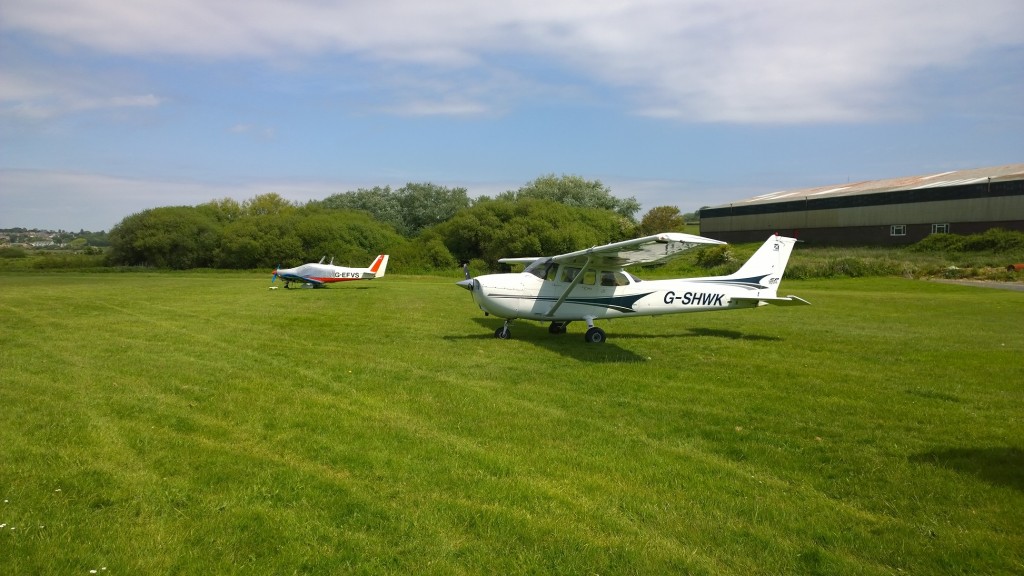
G-SHWK: Parked at Bembridge
By my measurements we were stopped in 350m, not the best I’ve ever done but perfectly good enough. I might enjoy short strip flying, but I don’t go out of my way to try and stop in 100m when 700m is available…….do that and one day it’s going to be very embarrassing, with people muttering about why you didn’t just use more of the runway etc.
Taxing off the runway, we could see that not surprisingly the club’s Cessna 182 had beaten us here (140 kt cruise), still nobody had jumped us in the take off order so the navigation must have been alright 🙂
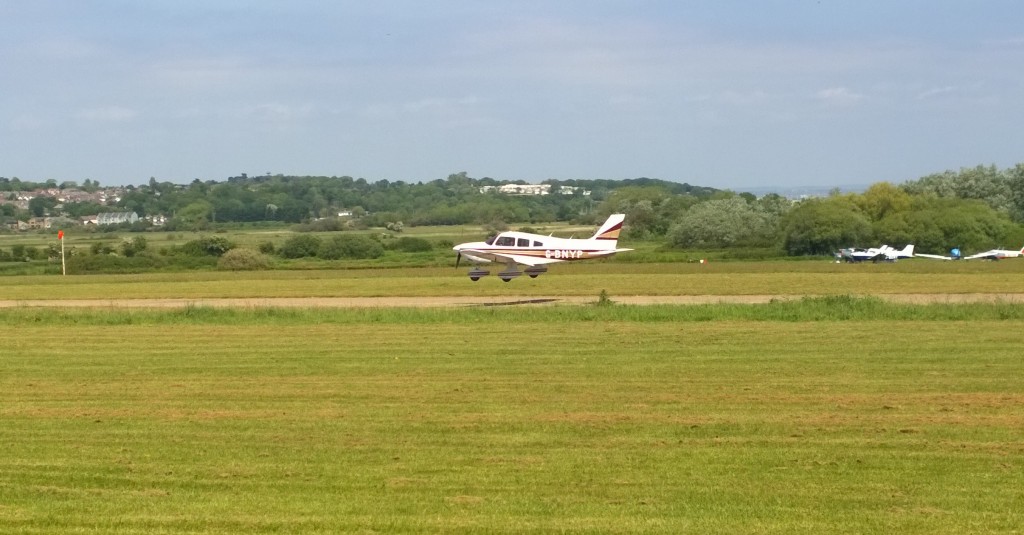
Plane Landing at Bembridge
While waiting around for one or two of the other club planes to arrive, there were a couple of other planes landing – quite a busy place really, but on such a nice day it makes sense.
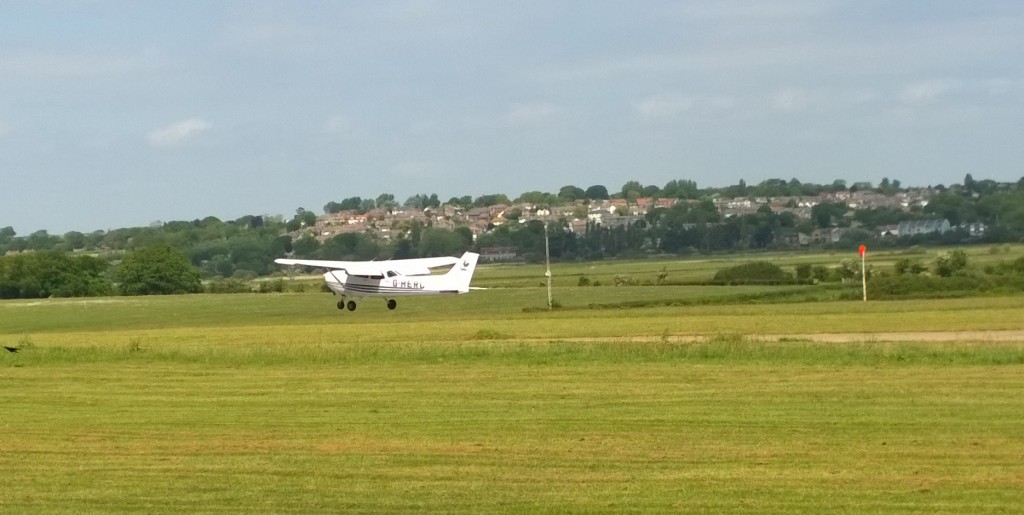
Another Club Plane lands
Fish and Chips by the Seaside
We talked about going into Bembridge town as a group, but when the taxi rocked up the driver said “you don’t want to go there, you want to go to Sandown, it’s about the same distance and there’s loads more choice.” Fair enough, drive on sir….
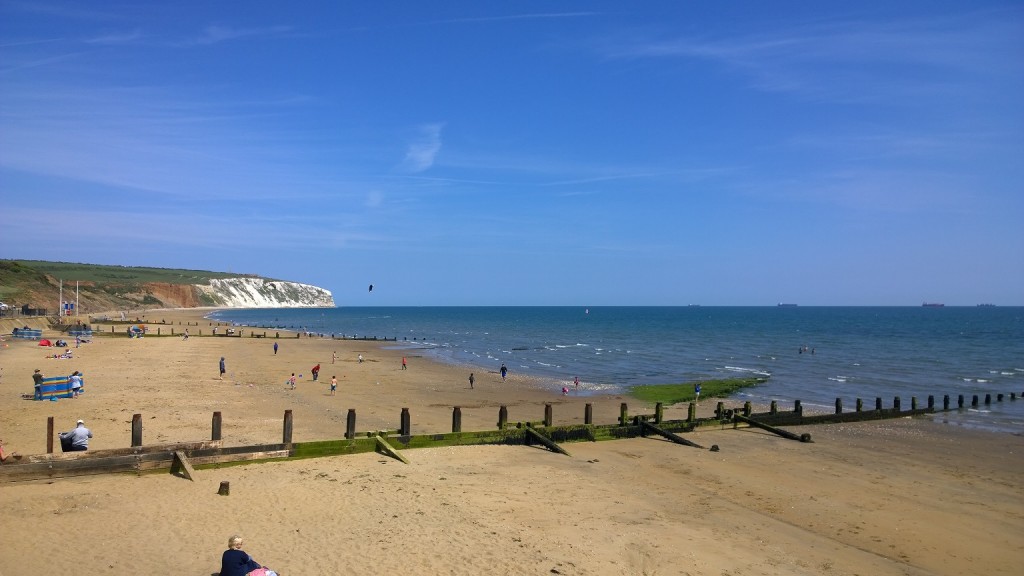
Sandown sea front
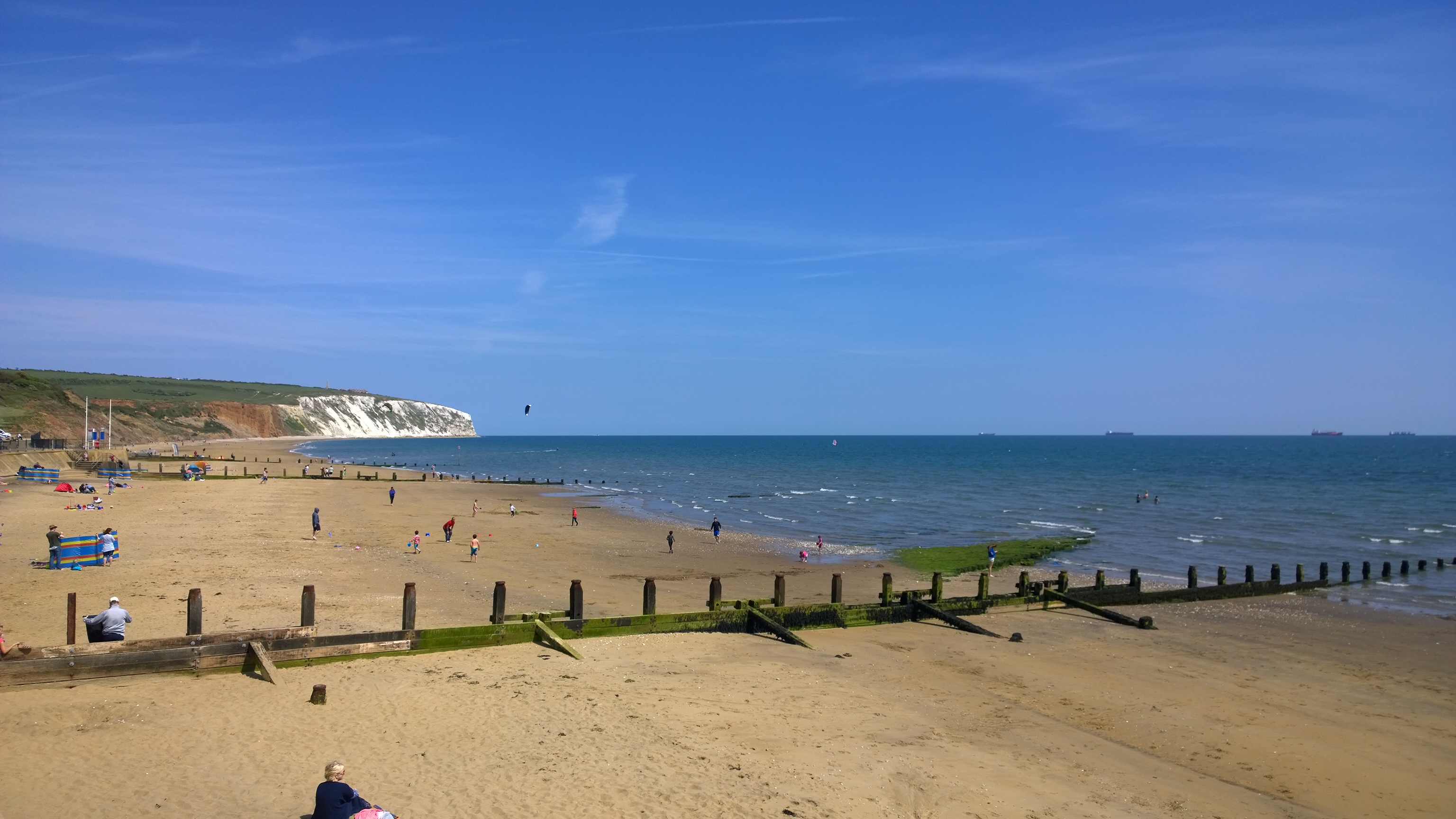
 A short walk along the sea front we found a restaurant that seemed nice enough and to the groups liking, serving fish and chips, gourmet burgers, steaks etc. (so good I can’t remember what the place was called!). Being very english and at the sea side, I had to go with the fish and chips…….quite a trek to get them, but sooo worth it 🙂
A short walk along the sea front we found a restaurant that seemed nice enough and to the groups liking, serving fish and chips, gourmet burgers, steaks etc. (so good I can’t remember what the place was called!). Being very english and at the sea side, I had to go with the fish and chips…….quite a trek to get them, but sooo worth it 🙂
After a short wander we all decided rather then getting a taxi back, we’d just walk it, a quick look on the phones suggested it would take ~50 minutes. As you can see in the photo’s it was a pretty nice day for a walk, so why not.
I’m sure we worried a few cars at times as in places the footpath became non-existant and there’s quite a few blind corners with very little to give between cars on the road and people walking on the side of the road 😐 But we made it work and were soon back at Bembridge Airport.
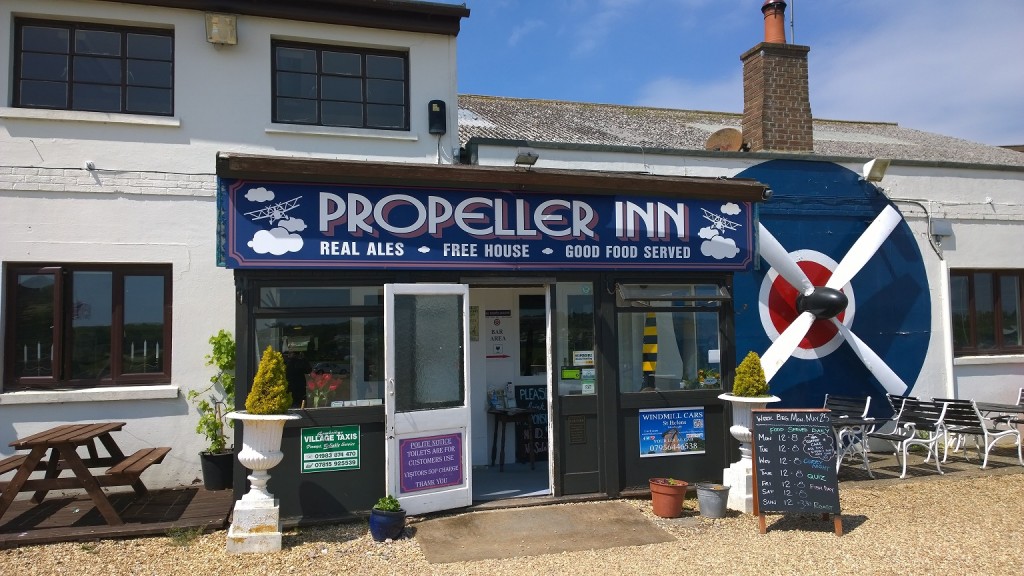
Propeller Inn
While we waited for the other three planes worth of club members to show up we set-up camp in the Propeller Inn. Nice enough little restaurant/pub.
Over coffee we talked about flying a lap around the island before heading home. The pilot flying the return leg seemed up for doing this and as he’d be paying to do the flying for that part I really had no grounds to object, seemed like a great idea to me.
For the return leg I had a few sights I wanted to try and spot, particularly I wanted to see if I could find Binstead Farm Strip, a 400m grass strip near Rye – a bit of local knowledge might be handy if I come back here one day.
Lap of the Isle of Wight: Before Returning the Long Way Round
You can see from the chart, that the route we planned back was very much “the long way round” back to Cambridge (Bambridge to Cambridge, via Lydd is far from a direct route!).
Just to make the route completely backwards instead of flying north/east after taking off from Bembridge on runway 12, we turned right and headed south 🙂
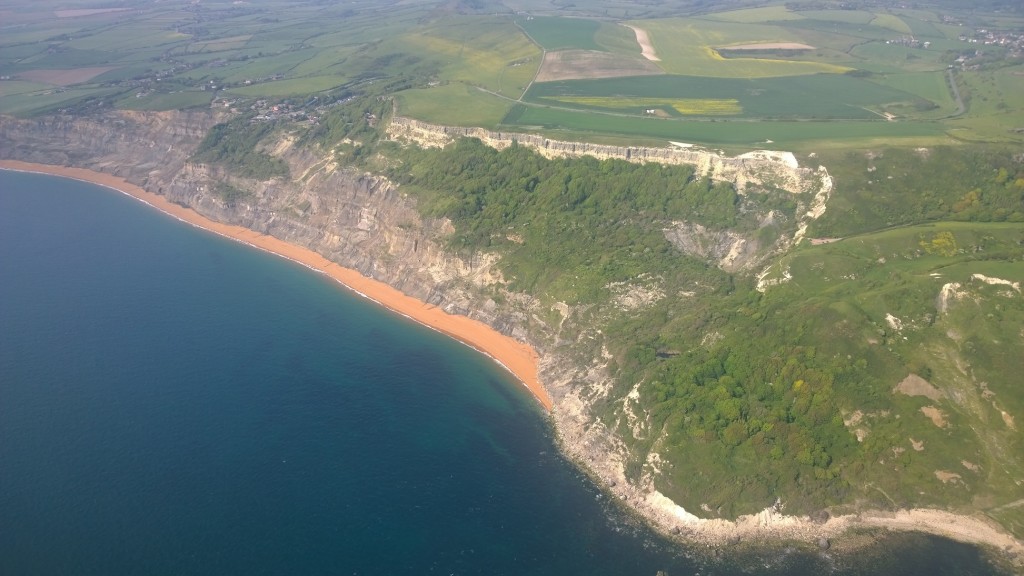
Isle of Wight Beaches
Nice day to go flying, I almost wished I was in the front seat as the air over the sea was really quite calm (or perhaps the pilot was doing a brilliant job!). There are times when being part of an aero club is really worthwhile, this was one of those days.
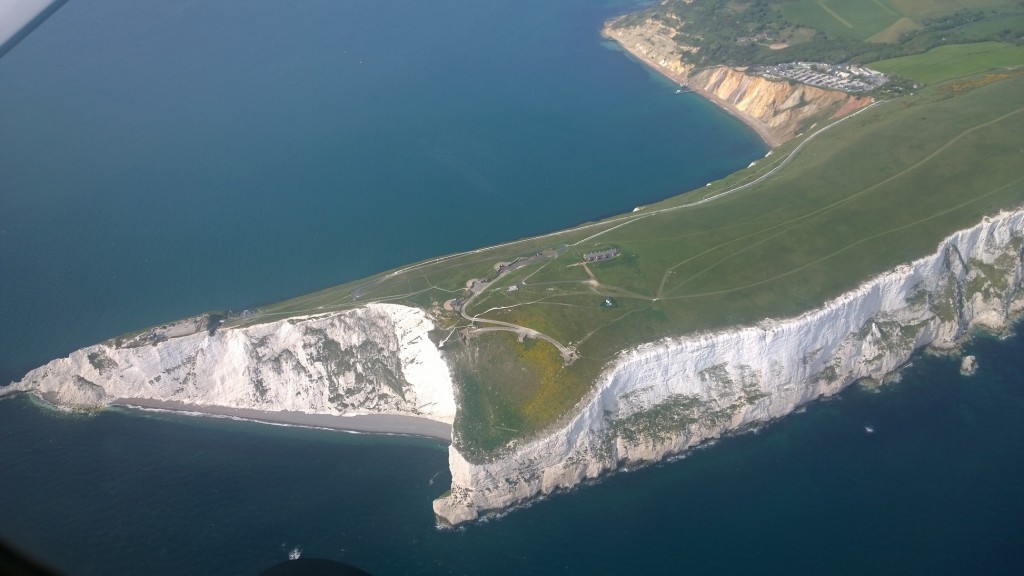
White cliffs near The Needles
As we got all the way around the island I went on the look out to see if I could spot Binstead Farm Strip. I’d played with the idea of borrowing the Cessna during the day to go try and land there, but one thing led to another on the day and it just turned out to be more fun to go off and get fish n chips with the ‘crew’ of G-SHWK. Still on Google Earth it looks like a wicked little farm strip, so never pass on a chance to recce a farm strip – there’s value in this because what it says on the owners plate and/or what they tell you on the phone doesn’t always tie up with what’s really there.
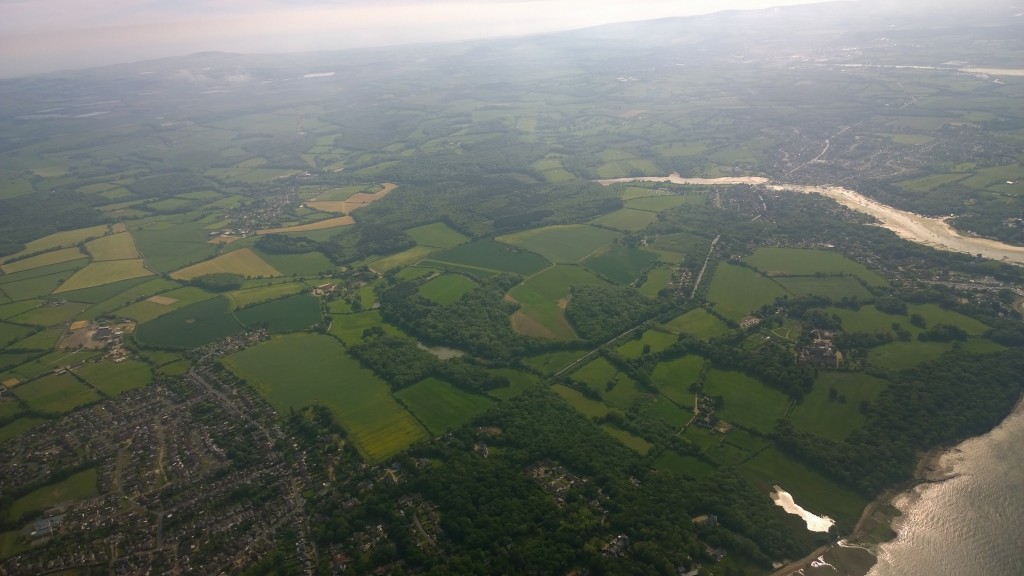
Binstead Farm Strip
Can you see it? Look dead centre, there’s a batch of trees and then just behind them is a straight longish rectangular patch of grass surrounded by darker grass, running left to right. That’s Binstead Farm strip. Note the road and estuary positions, should be easy enough to find again – I’ve put this on my hopeful list of places to come back and try one day.
Flight Home: Nice bit of Back Seat Navigation
The guys in the front seats had things well under control and the pilot was getting lots of opportunities for practicing things he didn’t tend to do – primarily getting zone transit permission through Southampton Control Area, followed by the now almost essential transit through “London” Southend’s new Control Area controlled air space (a somewhat controversial bit of controlled airspace that if they say “No” sort of cuts East Anglia off from traveling south via the east side of London!).

London Southend Runway
One of the Last Back
Those that had wanted to fly round the Isle of Wight had mostly done it on the way out there, because we did it on the way back, it meant we’d gone from being 1st or 2nd in the group of four to take off to being the last to land.
Still no real matter, we had all the clubs aircraft out today so it’s not like we were holding anyone else up by being back a bit later and one of the nicer things about flying from Cambridge Airport is that they don’t close the tower until 8pm.
Being summer there was no risk of needing night ratings.
I’ve flown in the circuit in separate Cessna’s and watched the pilot of the return leg home, land a couple of times – most recently only a few weeks before this trip because we were both sneaking in an early morning flight before the clubs usual lesson slots for students to maintain our currency. So I had no doubts he could land a plane.
Sure enough we touched down nicely and taxi’d back to the grass parking, top job!
A fun days flying, nothing left to do but hand back the life jackets and settle up the flying bill.
It took us 1 hour, 40 minutes (Chocks Off to Chocks On) to get down to Bembridge. Pretty good going, by comparison it’d take you about 4 hours in a car/ferry.
The return leg was immense and I’m thankful I wasn’t picking up the bill for that, but my thanks to the pilot who did fly the return leg, great flying and a pleasure to be a part of.
Another sucessful club fly away, I’m two for two since getting my PPL and here’s hoping the club keeps organising more trips because they make for great flying, a chance to go flying with other pilots/students and make destinations otherwise uneconomical actually quite affordable (splitting the bill the Isle of Wight is easily a cost effective flying trip), with a Cessna 172SP even better because you can split the bill and bring at least one passenger, maybe two depending on weight and balance etc.
Food for thought for another trip 🙂
